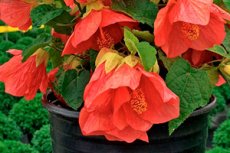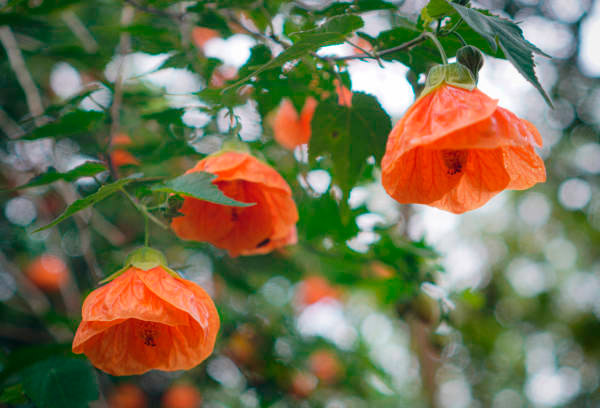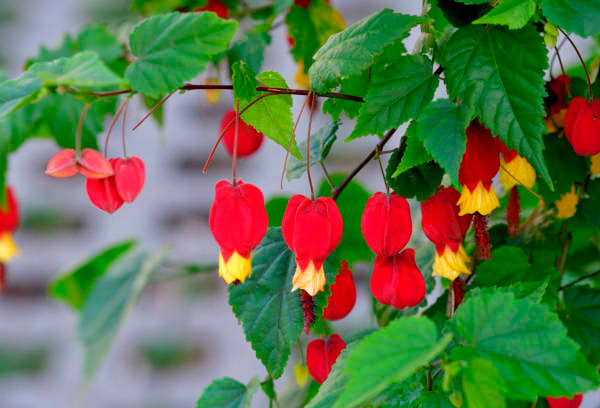New publications
Plants
Abutilon
Last reviewed: 29.06.2025

Abutilon is an evergreen plant that belongs to the Malvaceae family and is distinguished by its decorative leaves and beautiful bell-shaped flowers. It is often grown as an indoor plant due to its high decorative value, undemanding nature, and ability to bloom for extended periods.
Etymology of the name
The name "Abutilon" has Arabic origins and is related to historical descriptions of this genus in the works of medieval scholars. Later, the term was adopted into botanical nomenclature, where it became associated with a wide group of flowering plants found in the tropics and subtropics.
Life form
Abutilon is a semi-shrub or small shrub that can reach several meters in height in natural conditions. When grown indoors, its height is usually limited by the size of the pot and pruning methods.
In its natural environment, Abutilon forms a crown with densely branching shoots covered with large leaves. This structure allows the plant to efficiently use sunlight, contributing to abundant flowering and active growth during favorable conditions.
Family
Abutilon belongs to the Malvaceae family, which includes several ornamental and economically important crops such as hibiscus, cotton, and mallow. A common characteristic of plants in this family is their funnel-shaped or bell-shaped flowers, as well as the presence of hairy sepals or bracts in some species.
The Malvaceae family includes herbaceous plants, trees, shrubs, and semi-shrubs. This diversity is reflected in a wide range of morphological features; however, the most characteristic traits—palmately-lobed leaves, bright flowers with large corollas, and unique fruit structure (capsules)—are also present in Abutilon.
Botanical characteristics
Abutilon typically has heart-shaped or maple-like leaves with long petioles and serrated edges. Flowers are arranged singly or in small groups in the leaf axils, having a bell-shaped form, and can vary in color: from white and yellow to orange, pink, and red shades. The fruit is a multi-seeded capsule consisting of several segments.

Abutilon pictum
Chemical composition
The chemical composition of Abutilon is not considered unique in terms of containing pronounced alkaloids or essential oils. The main biologically active compounds are flavonoids, pigments, carbohydrates, and other secondary metabolites characteristic of herbaceous members of the Malvaceae family.
Origin
The native home of Abutilon is considered to be the tropical and subtropical zones of South America, Africa, and parts of Asia. In natural conditions, it grows on forest edges, riverbanks, and in areas with sufficient moisture and sunlight.
Abutilon was introduced to Europe as an ornamental plant around the 18th–19th centuries and has since gradually gained popularity among indoor gardening enthusiasts. Its flexible branches and large, beautiful leaves help create a tropical atmosphere in living spaces.
Ease of growing
Abutilon has earned a reputation as an undemanding plant that can grow successfully in a variety of conditions. By following basic care guidelines such as timely watering, adequate lighting, and fertilizing, Abutilon develops well and blooms abundantly, even for beginner gardeners.
However, it is important to remember that this plant prefers a moderately warm and humid microclimate, and sharp temperature fluctuations or prolonged droughts can weaken it and reduce its decorative value.
Species and varieties
There are several dozen species of Abutilon, as well as many hybrid varieties with varying leaf shapes, sizes, flower colors, and forms. The most well-known species include Abutilon pictum, Abutilon megapotamicum, and hybrid forms collectively called Abutilon x hybridum.

Abutilon megapotamicum
Size
In open ground in regions with tropical or subtropical climates, Abutilon can grow to 2–3 meters in height, forming a sprawling shrub with many side branches.
When grown indoors, the size is much smaller. The plant usually reaches a height of 60–150 cm, which is convenient for standard rooms and allows for compact crown formation if necessary.
Growth Rate
Abutilon is characterized by relatively fast growth rates. In favorable conditions, shoots can elongate by 20–30 cm in one season, and with sufficient root space and regular feeding, even more.
The rapid growth requires regular pruning to shape the crown and timely repotting into a larger pot or container as the root system expands.
Lifespan
In natural conditions, Abutilon is a perennial plant that retains the ability to bloom and form new shoots for several years. Under favorable climatic conditions and in the absence of severe stress factors, the plant can live quite a long time.
In indoor conditions, its life cycle can also span 3–5 years or more, provided proper care is given. Over time, the lower part of the shoot may become bare, so to maintain its decorative appeal, the plant should be periodically rejuvenated through pruning or cuttings.
Temperature
The optimal temperature range for Abutilon is 18–25 °C. Under these conditions, active growth and bud formation occur. Short-term temperature increases to 28–30 °C generally do not cause significant harm, though they may require increased watering and humidity.
When the temperature drops below 12–15 °C, plant growth slows down, and some leaf shedding may occur. Temperatures below 5–7 °C are critical: Abutilon loses its leaves and may die without additional protection.
Humidity
Abutilon prefers moderate or increased humidity. In overly dry conditions (less than 40% humidity), the plant may experience stress, which is manifested in yellowing and curling of the leaves. It is advisable to occasionally spray the leaves with soft water or use a humidifier.
However, excessive air humidity, especially when combined with poor circulation, increases the risk of fungal diseases. Therefore, it is essential to maintain balance by providing good ventilation in the room.
Lighting and room placement
Abutilon needs bright but diffused light. Direct sunlight during midday can scorch the leaves, but morning and evening sunlight is often beneficial for abundant flowering. The optimal location is an east or west-facing window, where the plant will receive enough light without being subjected to prolonged direct rays.
When light is insufficient, the plant stretches, leaves become pale, and flowering may not occur. In the winter, when the daylight hours shorten, supplemental lighting with phytolamps or fluorescent lights may be used.
Soil and substrate
The optimal soil mix for Abutilon consists of leaf mold (40%), sod soil (20%), peat (20%), and coarse-grained sand or perlite (20%). This proportion ensures good drainage and sufficient organic matter. The pH should be maintained in the range of 5.5–6.5. It is also essential to provide a drainage layer of expanded clay or gravel at the bottom of the pot to avoid water stagnation.
Watering
During the summer period, when evaporation is more intense, Abutilon requires regular and abundant watering. The soil should not dry out completely, but overwatering must be avoided. After each watering, wait for the top layer to dry out, but during hot weather, the soil should not dry out more than one-third of the root ball.
In winter, watering is reduced depending on the room temperature and the speed of soil drying. If the plant is in a cool room (15–18 °C), the interval between waterings may increase to prevent root rot.
Fertilizing and feeding
Abutilon responds well to regular feedings with complex mineral fertilizers containing all major macro- and micronutrients. During spring and summer, fertilizers are applied every 2–3 weeks, using formulations for flowering plants with an increased content of phosphorus and potassium.
In addition to root feeding, foliar spraying with diluted fertilizers in lower concentrations can also be done. In autumn and winter, the amount and frequency of feeding are reduced, considering the slowing growth rate.
Flowering
Abutilon can bloom almost year-round if it receives enough light, warmth, and nutrients. Flowers may appear singly or in small groups on a single shoot, and each bud can last for up to a week.
During active flowering, it is recommended to maintain a stable level of humidity and temperature, and provide additional light to the plant. Lack of lighting is a common reason for buds falling off before they open.
Propagation
Abutilon can be propagated throughout the spring-summer period when the plant is most active. The most common method is rooting stem cuttings about 8–10 cm long, which can be rooted in water or in a moist substrate. In warm conditions, roots form within 2–3 weeks.
It is also possible to grow Abutilon from seeds, but in this case, the decorative traits of hybrid varieties may not be preserved. The seeds are sown in a mixture of peat and perlite, maintaining humidity and a temperature of about 20–22 °C. Germination occurs within 7–14 days.
Seasonal features
In spring and summer, Abutilon actively grows and sets buds, so it is essential to provide regular watering and feeding during this period. In autumn, the growth rate gradually slows down, and by winter, the plant enters a relatively quiet phase.
In winter, when light and temperature decrease, Abutilon may partially shed its leaves. To maintain an attractive appearance, supplemental lighting is recommended. As spring arrives and the daylight increases, watering frequency gradually increases, and the first feeding is applied to stimulate the awakening of growth buds and new bud formation.
Care tips
Abutilon requires timely care procedures, including maintaining optimal humidity, temperature, and lighting levels. Regular inspection for diseases or pests allows for timely preventive measures.
Periodically, the leaves should be cleaned of dust using a soft sponge or warm shower. This not only improves the plant's appearance but also promotes more active photosynthesis.
Care at home
The first aspect of care is optimizing lighting. Abutilon is placed in locations with bright, but diffused light, with protection from direct sunlight if necessary. If natural light is insufficient, phytolamps should be used.
The second important aspect is proper watering and feeding. During active growth, ensure the substrate remains slightly moist but not waterlogged. Fertilize with complex fertilizers, prioritizing phosphorus and potassium.
The third recommendation concerns maintaining a comfortable temperature. Significant fluctuations, especially drops below 15 °C, can slow growth and cause bud drop or leaf loss. At the same time, excessively high heat (above 30 °C) requires additional measures to increase humidity and intensify watering.
Lastly, regular inspection of the root system is advisable. If the plant noticeably "outgrows" the pot, roots protrude from drainage holes, or the soil ball dries out too quickly, repotting into a larger container is necessary.
Repotting
The choice of pot depends on the size of the root system. The suitable pot should be 2–3 cm wider than the previous one, allowing roots to develop freely but not too spacious, as the substrate could become waterlogged. The material of the pot can be any (plastic, ceramic), but it must have drainage holes.
Repotting should be done in spring or early summer, when the plant is in active growth. First, remove part of the old substrate, inspect the roots, and trim damaged sections if necessary. Then, place the Abutilon in a new container with prepared soil mix.
Pruning and shaping the crown
To maintain a compact form and stimulate branching, regular pruning is recommended. The shoots are shortened by 1/3 or 1/2 of their length, encouraging the active growth of side branches.
It is best to prune the plant in early spring when growth processes are awakening. If the shoots become excessively elongated during the season, light trimming of the crown is allowed.
Possible problems and their solutions
The most common issues when growing Abutilon are fungal diseases (e.g., gray mold) and pests (aphids, spider mites). These problems often arise from overwatering or excessive humidity. To address these, fungicides and insecticides can be used, along with adjusting the growing conditions.
A deficiency in nutrients may cause leaf paleness, slow growth, and poor flowering. In this case, the appropriate fertilizers should be applied. Care mistakes such as irregular watering or insufficient light often lead to leaf and bud drop.
Pests
The main pests of Abutilon are aphids, whiteflies, spider mites, and scale insects. Their active development is stimulated by warm, dry air and overcrowding of pots on windowsills. To prevent this, regularly inspect the leaves, wipe them with a damp sponge, and ventilate the room.
In the case of an infestation, chemical treatments (insecticides) should be used, strictly following the instructions. In some cases, biocides or folk remedies (green soap solution, garlic or onion infusions) may help.
Air purification
Abutilon is considered one of the plants that help purify the air of harmful impurities. Its broad leaves capture and process carbon dioxide and help humidify the atmosphere, which is especially beneficial during the heating season.
Additionally, the plant can partially adsorb some volatile organic compounds emitted by household chemicals or finishing materials. However, Abutilon should not be regarded as the main filter—it is merely an additional means of improving the microclimate.
Safety
Abutilon is not considered a toxic plant and usually does not cause serious allergic reactions. However, for individuals with heightened sensitivity or allergies, it is better to carefully monitor contact with the leaves or flowers and avoid contact with plant sap on open wounds.
For pets, Abutilon is not particularly dangerous, but if the leaves (especially young shoots) are ingested, digestive upset may occur. If poisoning is suspected, it is advisable to consult a veterinarian.
Wintering
During winter, with the reduction of daylight and lower temperatures, the plant may enter a resting phase with slowed growth and sparse flowering. It is optimal to maintain a temperature of 15–18 °C and reduce watering. If the temperature exceeds 20 °C and light is insufficient, shoots may stretch, and leaves may fall off.
With the arrival of spring, when the daylight increases, gradually raise the watering frequency and apply the first feeding to stimulate the awakening of growth buds and the formation of new buds.
Beneficial properties
Abutilon not only decorates the interior but also has a positive effect on emotional well-being, improving the atmosphere of the room. Having a blooming and healthy bush in the room helps create a harmonious environment.
Additionally, some studies suggest that members of the Malvaceae family may release phytoncides that reduce the overall number of harmful microbes in the air. While the evidence is limited, many gardeners report improvements in the microclimate.
Use in traditional medicine or folk remedies
In several traditional cultures, the leaves and flowers of Abutilon are used as a supplementary remedy for colds, prepared as infusions or decoctions. However, official medicine does not confirm the high efficacy of these methods, so such recipes should be used with caution.
In some regions, collected flowers and leaves are dried and added to herbal teas. It is believed that they may have a mild anti-inflammatory effect, but scientific confirmation is scarce.
Use in landscape design
Abutilon, with its lush crown and large, striking flowers, is well-suited for creating decorative compositions in winter gardens, greenhouses, and even on outdoor terraces (in the warm season). It can be combined with other tropical plants to create vibrant color accents.
Vertical gardens and hanging compositions with Abutilon are also popular. Thanks to its hanging shoots and abundant flowering, the plant adds volume and decoration to green walls and balcony planters.
Compatibility with other plants
Abutilon coexists well in group plantings with plants that prefer moderate humidity and similar temperature regimes, such as hibiscus or begonias. Its large leaves create a striking green mass that highlights the small or highly contrasting flowers of neighboring plants.
When placed in common compositions, it is important to consider its need for space: Abutilon grows quickly and may shade its neighbors. Regular pruning of shoots will help maintain a harmonious combination with other species.
Conclusion
Abutilon is a bright representative of the Malvaceae family and can become a true decoration of any interior. Its beauty, low maintenance, and wide range of varieties make it attractive for both experienced gardeners and beginners.
With proper care, Abutilon can delight with abundant flowering almost year-round, improving mood and enhancing the indoor microclimate. Observing the growth and development of this amazing shrub provides pleasure for gardeners and connects them with the world of tropical flora.
